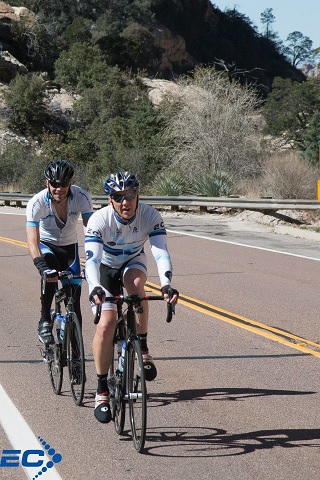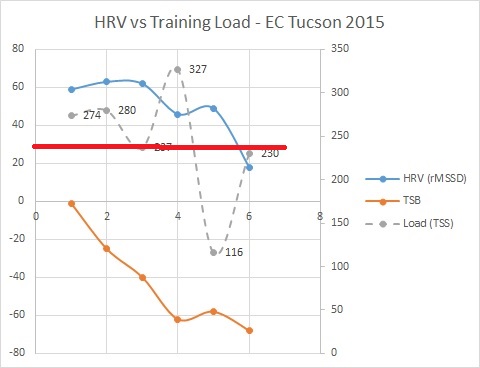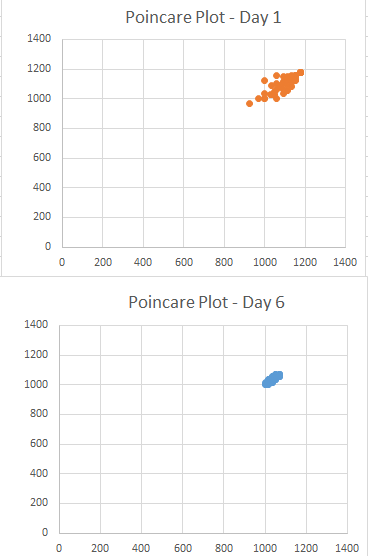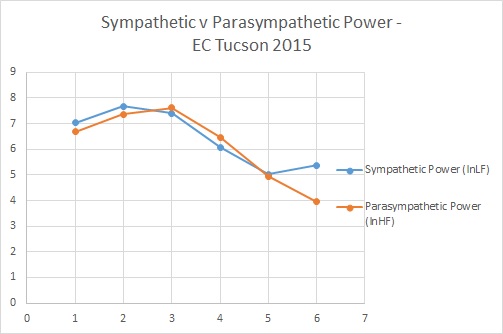HRV over a training camp: A (tiring) case study :-)
Alan Couzens, MS (Sports Science)
March 4th, 2015

Above: The EC Tucson Gang (while our heart beats were still ‘variable’ :-)
Over the past few weeks, I’ve presented some content on the theory behind using HRV to optimize your training (here, here, here and here). In this post, I want to put the theory into practice by looking at how HRV metrics change over the course of real training &, as any self respecting scientist knows, there is no better way to identify effects than to crank up the stimulus. So, for you, loyal readers, that is exactly what I did by jumping into some pretty extreme loading at our annual EC Tucson camp :-)
I went into the camp with neutral ‘freshness’ (TSB=0) and a relatively moderate fitness level - Chronic Training Load (long term average) of 70TSS/d. You can see from the numbers below that each day was significantly above that long term average load, most by a factor of 3-4! In other words, the loads were definitely a shock to the system - as the HRV data will attest!
The camp load broke down as follows:
Day 1 – Big (274TSS)
- 3800m Swim w/~1800m Moderate & 900m Threshold work (coached by Cliff English)
- 2hr bike w/20min TT at a solid effort (321W)
- 50 min Easy Run
Day 2 – Big (279TSS)
- 6.5hr Easy-Steady Ride to Madera Canyon
Day 3 – Big (237TSS)
- 3200m Swim – Stroke focus w/500m of threshold-threshold+ work
- 2.5hr Easy Spin
- 50min Aerobic Run
Day 4 – Epic (327TSS)
- 5.75hr Ride w/2hr Moderate-Thresh Climb (247W avg) Mt. Lemmon

Jeff - doing his part on day 4 to 'disrupt my autonomic balance' :-)
Day 5 – Maintenance (117TSS)
- 3300m Swim w/600m Moderate and 200m of speed work as a draft set
- ~7K Track Workout – Drills, form & Basic Speed. (coached by Marilyn Chychota)
Day 6 – Big (237TSS)
- 6hr Easy Ride to Kitt Peak
I tracked my heart rate variability numbers in the morning and at the completion of workouts. My morning trends for rMSSD and how they relate to both my training stress balance (TSB) and the daily load are shown below…

A relatively clear relationship is evident, particularly from mid week on. This same pattern of HRV ‘showing up’ mid way through an overload block was also seen in a neat study that tracked HRV patterns in professional cyclists over the Vuelta (Earnest et al., 2004) & ties in with the general finding from over-reaching studies that athletes can tolerate large shifts in load without ill effect providing that the loading period is not prolonged.
While, HRV numbers tend to be quite specific to the individual, in the interests of context, I placed a red line on the chart at the level of rMSSD that denoted true overtraining symptoms (prolonged diminished performance, inability to complete the training load, depression, chronically elevated cortisol levels) in a study by Mourot et al. (2004) (rMSSD=27ms) It is not coincidental, that we, at Endurance Corner, have arrived at a 6 day camp as optimal in terms of loading duration. We have ‘experimented’ over the years and have found that camp durations beyond this period often lead to ill effect.
Another neat way to visualize the change in variability over a big week is via Poincare plots, which plot the difference (in milliseconds) between successive beats. In terms of a responsive system, we want to see a 'shotgun' profile. When we see a 'center mass' profile, it is a sign that the athlete is tired. My Poincare plots from Day 1 and 6 over the training camp are shown below. You can see this trend towards a 'center mass' profile over the week.

Delving a little deeper into the data, I’ve also presented the LF/HF numbers from the camp below.

As I outlined in a previous post, these numbers offer some really useful insight into ‘how’ the athlete is tired, i.e. whether their sympathetic nervous system (their ‘do work’ system) is tired or whether their parasympathetic ‘rest and digest’ system is tired. You can see some interesting trends from the chart in that respect.
Going into camp, it is quite common for an athlete to have an elevated sympathetic response. A lot of this is not necessarily related to the training but just a factor of getting a group of competitive, Type A, maybe a bit nervous, folks together for the first time. My own LF/HF ratio 2 days before camp was over 4.0 (not shown) – indicating a very strong sympathetic response of ‘pre-camp jitters’. A 5hr very easy pre-camp ‘shake out’ ride sorted that out & I would guess that for many campers that LF/HF gap was much greater over those initial days.
By day 3, the sympathetic system was settling and the rest and digest tendencies were being felt. After a strong effort on Mt. Lemmon, both systems were tired and the rest and digest tendencies were stronger still – in the form of massive caloric consumption & ‘pass out’ mid day naps :-)
Day 5 was a similar trend and on Day 6, something interesting happened – the sympathetic system rallied somewhat, while the parasympathetic system continued its downward slide. In my opinion/experience, this is the beginning of a very dangerous trend for the endurance athlete – where the sympathetic system is strong enough to get the work done but the parasympathetic system is not strong enough to absorb it, or, more specifically, to force the system to shut down long enough to absorb it. This ‘sympathetic dominance’ during overtraining can be more dangerous than the contrasting vagal dominance because being ‘jacked up’ prevents the athlete from resting when they need to the most (!) & can lead to sleeplessness, irritability and an overall catabolic trend that can do a lot of harm. In this sense, there is high value in keeping an eye on that HF number. Beyond preventing you from really hurting yourself, that number has other merits…
As I’ve suggested before, a strong relationship exists between the athlete's training response and HF power. The Hautala study that I keep referencing showed a more than 3x difference in the training response (increase in VO2max) to a given training load for athletes with lnHF numbers of 7.1 vs those with lnHF numbers of 5.7 & I've seen a similar (albeit short term) relationship in the athletes that I am tracking (below)

The implications are clear in terms of the benefit of training (or lack thereof) when you start seeing your lnHF numbers heading south of 6. At these times, a more productive use of your time may be to replace some training time with pursuits designed to proactively ‘build back up’ your parasympathetic strength. That is what I have been doing this week (and will continue to do until I see some improvement in my HF power).
You’ll notice a common theme in these HRV posts – that optimizing training is largely about yin and yang variability – build the adaptation reserves up and then use those reserves to lay down some strong (specific) training. Rinse and repeat. In this sense, it’s easy to see how well placed training camps fit in & offer far more value than the monotonous, constant stress weeks that typify the schedule of working athletes. I hope to have the opportunity to ‘get appropriately tired’ right alongside you at one of our future camps.
Train smart,
AC
Tweet**************************
Don't miss a post! Sign up for my mailing list to get notified of all new content.
**************************
